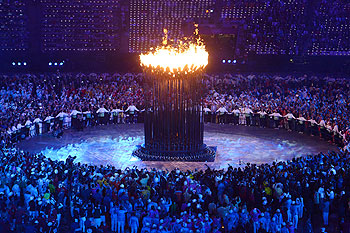 | « Back to article | Print this article |
The Olympic flame is nowhere to be seen.
The enduring image of the Summer and Winter Games, lit Friday night at the climax of the opening ceremony, is out of sight from the throngs of fans who hoped to catch an inspiring glimpse or take the photo of a lifetime.
- London Olympics 2012 - Complete coverage
The cauldron sits low in the center of Olympic Stadium in London, invisible from the outside. It will be moved Sunday to a corner, and visible in person only to fans lucky enough to have tickets to track and field, which starts Friday.
 Until then, if you want to see the Olympic flame, you'll have to settle for a beauty shot on television, where it looks from above like a small, distant campfire, or the pilot light under the eye of a giant stove.
Until then, if you want to see the Olympic flame, you'll have to settle for a beauty shot on television, where it looks from above like a small, distant campfire, or the pilot light under the eye of a giant stove.
"It's unfortunate," said John Morrissey, who traveled to London on a day trip from Ireland on Saturday, the first day of competition. "I didn't realise you couldn't see it. I was going to walk around until I saw it. It seems quite poorly thought out."
"That could have been made more user-friendly," said Lorraine Payne, an airline worker from London.
The designer of the cauldron, Thomas Heatherwick, offered an artistic defense: "It's almost that the stadium represents some kind of temple and it's the flame that sits in the heart of that temple."
"We were aware that cauldrons have been getting bigger, higher, fatter as each Olympics has happened," he said.
Indeed, Beijing was a tough flame to follow. The Summer Games in 2008 featured a mammoth, spiraling cauldron attached to the inner roof of the stadium, so big that it dwarfed the wire-suspended gymnast who spacewalked around the rim to light it.
At the last Winter Games, in Vancouver in 2010, there was an outcry when organizers put the cauldron behind an unsightly chain-link fence along the harbor, touching off a "free the flame" movement.
Organisers ultimately ceded to public demand and opened up a rooftop promenade that allowed an elevated, unobstructed view for the thousands of people who came to the site every day to take photos.
This isn't the first time the Olympic flame has been kept inside a stadium in London. In fact, designers said they wanted to replicate the 1948 Olympics in London, when the cauldron was placed in a corner of Wembley Stadium.
"With the technology we now have that didn't exist at the time it can be shared with everyone in the park with screens," Heatherwick said. "We felt that sharing it with the screens reinforces the intimacy."
Before arriving for the opening ceremony, the flame had traveled across the UK in a 70-day torch relay covering 8,000 miles. Organisers said that public exposure -- 15 million Britons have seen it -- was more important than showing it off in a park.
The design and location of the cauldron were among the most closely guarded secrets of the games. The plans were devised two years ago with opening ceremony director Danny Boyle, the Oscar-winning filmmaker.
The London Olympic planners started with the assumption that the cauldron should be on top of the stadium, sticking up like the antenna on a cellphone, Heatherwick said.
But it dawned on them that the stadium was almost a perfect circle, he said, "and that the most powerful spot in the whole of that stadium is the very, very center."
Turning it into a beacon would have meant making it bigger, and that would not have met Boyle's and the designers' vision of "making something that was rooted in where people were," Heatherwick said.
The whole cauldron project -- which was approved by Prime Minister David Cameron -- was so hush-hush that secret rehearsals were held in the town of Harrowgate in northern England.
For the final tests inside the Olympic Stadium, only four people took part, waiting until 3 a.m., after all the volunteers and performers had gone and no helicopters were flying overhead.
After the flame is extinguished August 12, the cauldron will be taken apart and exist no more. Each of the 205 countries competing in the games will take a petal home with them.
For now, the flame isn't completely in the dark. Images are being projected on big screens around Olympic Park, the complex of venues in the East End of London. Ever the civic booster, Mayor Boris Johnson said everyone should relax.
"It's going to be visible to everybody who watches it on TV," he said. "It's there. I don't think it's a big deal."
To Tanja Schmitt, a 27-year-old visitor from Frankfurt, Germany, it was sad.
"I had wanted to see the flame, but I'm not going to any athletics events, so I won't be able to get in the stadium."
The International Olympic Committee is leaving the matter to London organizers, spokesman Mark Adams said.
"We allow people to have cauldron where they want it," he said. "There have been precedents before. This echoes what happened in 1948. We're fully supportive of the decision they've taken."
Photograph: Roger Sedres / Gallo Images /Getty Images